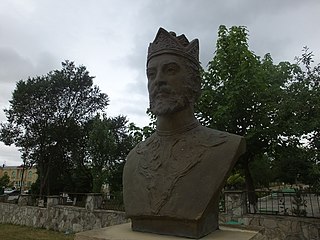Related Research Articles

Ibrahim I was the 33rd Shirvanshah. Because of his cunning politics he managed to remain independent and avoid being deposed by the Turko-Mongol ruler Timur.

Khalilullah I, also known as Sultan-Khalil (سلطان-خلیل), was the Shirvanshah from 1418 to 1465. He was the son and successor of Ibrahim I. He was succeeded by his son Farrukh Yasar.

Farrukh Yasar was the last independent Shirvanshah of Shirvan (1465–1500). In 1500, the first Safavid ruler, Ismail I, decisively defeated and killed Farrukh Yasar during his conquest of the area. Descendants of Farrukh Yasar continued to rule Shirvan under Safavid suzerainty, until 1538, when Ismail's son and successor Tahmasp I appointed its first Safavid governor, and made it a fully functioning Safavid province.

The Ildegizids, Eldiguzids or Ildenizids, also known as Atabegs of Azerbaijan were an Atabegate of the Seljuk Empire, and a Sunni Muslim Turkic dynasty, which controlled most of northwestern Persia, eastern Transcaucasia, including Arran, most of Iranian Azerbaijan, and Jibal. At their maximum extent, the territory under their control, roughly corresponds to most of north-western Iran, most of the regions of modern Azerbaijan and smaller portions in modern Armenia, Turkey and Iraq. Down to the death in war 1194 of Toghril b. Arslan, last of the Great Seljuq rulers of Iraq and Persia, the Ildenizids ruled as theoretical subordinates of the Sultans, acknowledging this dependence on their coins almost down to the end of the Seljuqs. Thereafter, they were in effect an independent dynasty, until the westward expansion of the Mongols and the Khwarazm-Shahs weakened and then brought the line to its close.

The Sallarid dynasty, was a Muslim dynasty of Daylami origin, which ruled in Tarom, Samiran, Daylam, Gilan and subsequently Azerbaijan, Arran, and some districts in Eastern Armenia in the 2nd half of the 10th century. They constitute part of the period in history that has been named the Iranian Intermezzo, a period that saw the rise of native Iranian dynasties during the 9th to the 11th centuries.

The Shirvanshahs were the rulers of Shirvan from 861 to 1538. The first ruling line were the Yazidids, an originally Arab and later Persianized dynasty, who became known as the Kasranids. The second ruling line were the Darbandi, distant relatives of the Yazidids/Kasranids.

Shaykh Haydar or Sheikh Haydar was the successor of his father as leader of the Safavid order from 1460 to 1488. Haydar maintained the policies and political ambitions initiated by his father. Under Sheikh Haydar, the order became crystallized as a political movement with an increasingly extremist heterodox Twelver Shi'i coloring and Haydar was viewed as a divine figure by his followers. Shaykh Haydar was responsible for instructing his followers to adopt the scarlet headgear of 12 gores commemorating The Twelve Imams, which led to them being designated by the Turkish term Qizilbash "Red Head".
Lashkar Haytham ibn Khalid was the first Shirvanshah, or independent ruler of Shirvan, renouncing the suzerainty of the Abbasid Caliphate in 861 after the Anarchy at Samarra and beginning the rule of the Mazyadid or Yazidid dynasty.

Yazid ibn Ahmad or Yazid II was the tenth Shirvanshah.
Manuchihr, Minuchihr or Manuchehr I was the eleventh Shah of Shirvan. He is considered to be first fully Persianized ruler of the dynasty. Starting from his rule, the Shirvanshahs favoured names from the pre-Islamic Iranian past and claimed descent from characters such as the Sasanian monarch Bahram V Gur.

Fakhr al-Din Fariburz ibn Sallar, better simply known as Fariburz I (فریبرز), was the sixteenth Shah of Shirvan, ruling from 1063 to 1096. His reign saw many major political balance changes in Caucasus, including expansion by the Seljuqs. He was considered a ruler with great diplomatic skills, and his kingdom extended from Mughan to Kumuk and Alania.
Bahram Beg was the 37th Shirvanshah, and ruled over Shirvan under Safavid suzerainty. Despite the enmity that existed between the Shirvanshahs and the ruling Safavid dynasty, Safavid king Ismail I allowed, after his conquest and defeat of Bahram's father Farrukh Yassar, the latter to rule as a Safavid subject.
Burhan Ali or Sultan Burhaneddin was a self-declared Shah of Shirvan.
Mehrab Mirza was the self-declared Shah of Shirvan after the death of Burhan Ali.
Ibrahim I ibn Marzuban I was the Sallarid ruler of Dvin (957–979) and later Azerbaijan. He was the son and successor of Marzuban ibn Muhammad.
Amir Tahmuras Darbandi was a member of House of Shirvanshah, ruling dynasty of Shirvan. He was a great-grandson of Shirvanshah Keykubad I and cousin of Khalilullah I.
Sultan Muhammad was a member of the Kasranid branch of Shirvanshah dynasty, as well as the ancestor of Darbandid branch of the family.
House of Derbent or Darbandids was a younger branch of Shirvanshahs that succeeded Kasranids.
Badr Shirvani was a Persian poet. He spent most of his career at the court of the Shirvanshahs, but received patronage from other rulers as well.
The High Middle Ages, or Classic Feudalism Period in what constitutes the present-day Republic of Azerbaijan, lasted from around the 11th century to the 15th century AD. The High Middle Ages were preceded by the Early Middle Ages and were followed by the Late Middle Ages, which ended around the 15thcentury AD. Key historical trends of the High Middle Ages include the incorporation of the territories that constitute present-day Azerbaijan into the Seljuk Empire, the establishment of the Eldiguzids, the Mongol invasions and the rule of the Ilkhanate, the invasions of Timur and the establishment of the Turkoman Kara Koyunlu and Aq Qoyunlu tribal confederations.
References
- ↑ V. F. Minorsky, A History of Shirvan and Darband, 1963, p.170-171